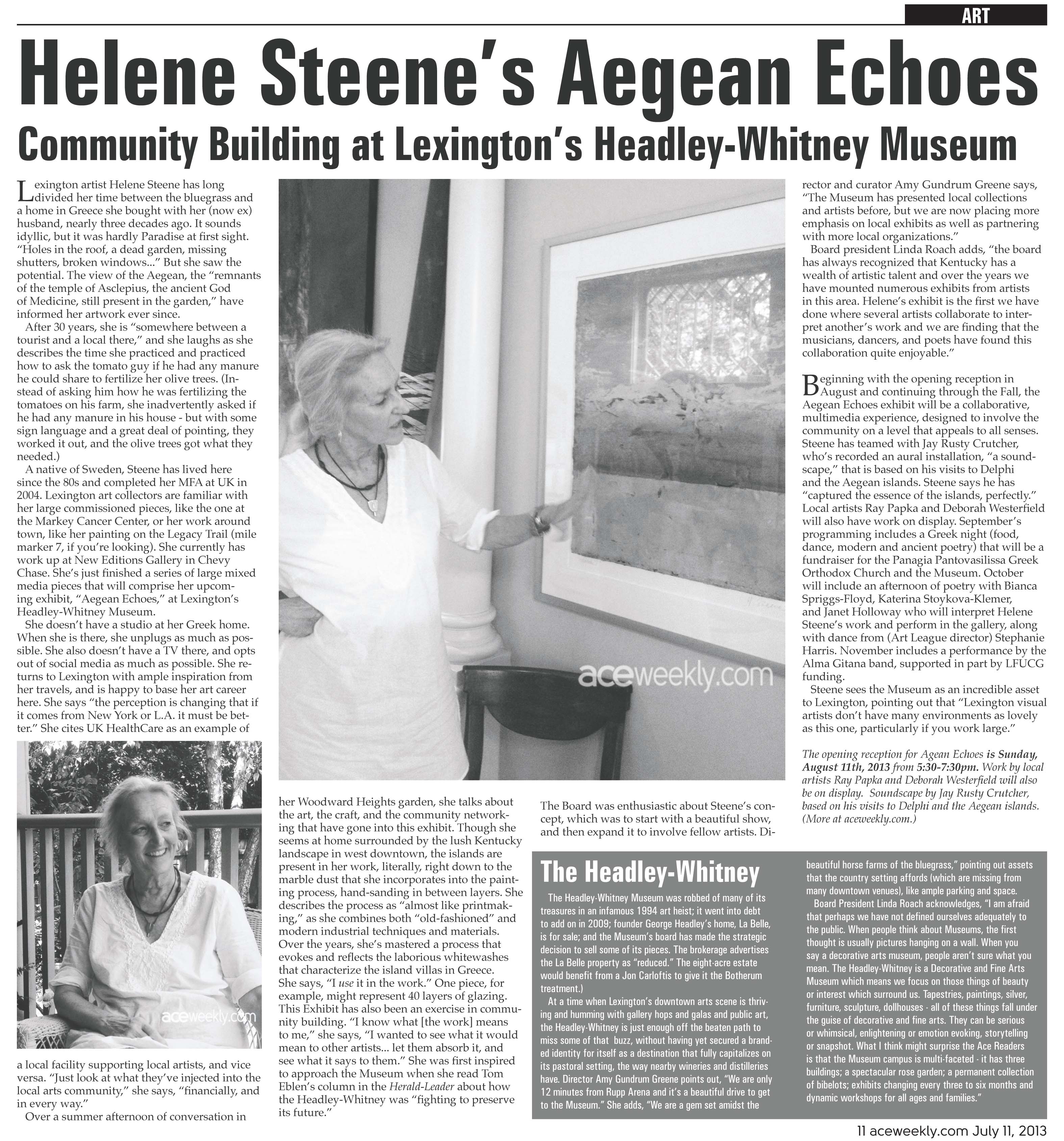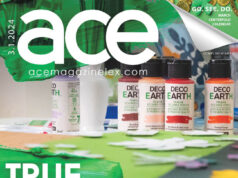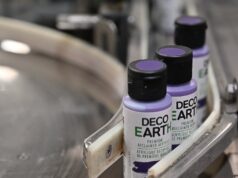[three_fifth]
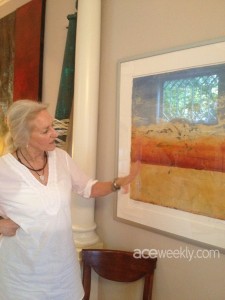

After 30 years, she is “somewhere between a tourist and a local there,” and she laughs as she describes the time she practiced and practiced how to ask the tomato guy if he had any manure he could share to fertilize her olive trees. (Instead of asking him how he was fertilizing the tomatoes on his farm, she inadvertently asked if he had any manure in his house — but with some sign language and a great deal of pointing, they worked it out, and the olive trees got what they needed.)
A native of Sweden, Steene has lived here since the 80s and completed her MFA at UK in 2004. Lexington art collectors are familiar with her large commissioned pieces, like the one at the Markey Cancer Center (“Shimmer at the Edge,”) or her work around town, like her painting on the Legacy Trail (mile marker 7, if you’re looking). She currently has work up at New Editions Gallery in Chevy Chase. She’s just finished a series of large mixed media pieces that will comprise her upcoming exhibit, “Aegean Echoes,” at Lexington’s Headley-Whitney Museum.
She doesn’t have a studio at her Greek home. When she is there, she unplugs as much as possible. She also doesn’t have a TV there, and opts out of social media as much as possible. She returns to Lexington with ample inspiration from her travels, and is happy to base her art career here. She says “the perception is changing that if it comes from New York or L.A. it must be better.” She cites UK HealthCare as an example of a local facility supporting local artists, and vice versa. “Just look at what they’ve injected into the local arts community,” she says, “financially, and in every way.”
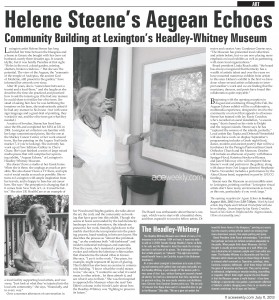


Over a summer afternoon of conversation in the garden behind her home in Woodward Heights, she talks about the art, the craft, and the community networking that have gone into this exhibit. Though she seems utterly at home surrounded by the lush landscape in west downtown, the islands are present in her work, literally, right down to the marble dust that she incorporates into the painting process, hand-sanding in between layers. She describes the process as “almost like printmaking,” as she combines both “old-fashioned” and modern industrial techniques and materials. Over the years, she’s mastered a process that evokes and reflects the laborious whitewashes that characterize the island villas in Greece. She says, “I use it in the work.” One piece, for example, might represent 40 layers of glazing.
This Exhibit has also been an exercise in community building. “I know what [the work] means to me,” she says, “I wanted to see what it would mean to other artists… let them absorb it, and see what it says to them.” She was first inspired to approach the Museum when she read Tom Eblen’s column in the Herald-Leader about how the Headley-Whitney was “fighting to preserve its future.”
The Board was enthusiastic about Steene’s concept, which was to start with a beautiful show, and then expand it to involve fellow artists. Director and curator Amy Gundrum Greene says, “The Museum has presented local collections and artists before, but we are now placing more emphasis on local exhibits as well as partnering with more local organizations.”
Board president Linda Roach adds, “the board has always recognized that Kentucky has a wealth of artistic talent and over the years we have mounted numerous exhibits from artists in this area. Helene’s exhibit is the first we have done where several artists collaborate to interpret another’s work and we are finding that the musicians, dancers, and poets have found this collaboration quite enjoyable.”
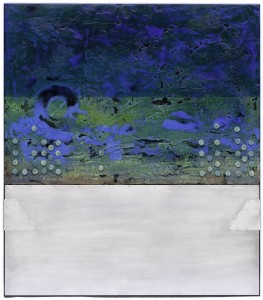

Steene sees the Museum as an incredible asset to Lexington, pointing out that “Lexington visual artists don’t have many environments as lovely as this one, particularly if you work large.”
This story appeared in Ace’s July 2013 Print edition on page 11.
[/three_fifth]
[two_fifth_last]
The Headley-Whitney
The Headley-Whitney Museum was robbed of many of its treasures in an infamous 1994 art heist; it went into debt to add on in 2009; founder George Headley’s home, La Belle, is for sale; and the Museum’s board has made the strategic decision to sell some of its pieces. The brokerage advertises the La Belle property as “reduced.” (The eight-acre estate would benefit from a Jon Carloftis approach to give it the Botherum treatment.)
At a time when Lexington’s downtown arts scene is thriving and humming with gallery hops and galas and public art, the Headley-Whitney is just enough off the beaten path to miss the buzz, without having yet secured a branded identity for itself as a destination that fully capitalizes on its pastoral setting, the way nearby wineries and distilleries have. Director Amy Gundrum Greene points out, “We are only 12 minutes from Rupp Arena and it’s a beautiful drive to get to the Museum.” She adds, “We are a gem set amidst the beautiful horse farms of the bluegrass,” pointing out assets that the country setting affords (which are missing from many downtown venues), like ample parking and space.
Board President Linda Roach acknowledges, “I am afraid that perhaps we have not defined ourselves adequately to the public. When people think about Museums, the first thought is usually pictures hanging on a wall. When you say a decorative arts museum, people aren’t sure what you mean. The Headley-Whitney is a Decorative and Fine Arts Museum which means we focus on those things of beauty or interest which surround us. Tapestries, paintings, silver, furniture, sculpture, dollhouses – all of these things fall under the guise of decorative and fine arts. They can be serious or whimsical, enlightening or emotion evoking, storytelling or snapshot. What I think might surprise the Ace Readers is that the Museum campus is multi-faceted – it has three buildings; a spectacular rose garden; a permanent collection of bibelots; exhibits changing every three to six months and dynamic workshops for all ages and families.”
Related archives
2004: “Art in the Country: Ace’s 15th anniversary exhibit at the Headley-Whitney,” July 2004. Read here.
The Art of Sybil at the Headley-Whitney. 12.2010.
Art is Strong Medicine: Model Lexington Programs 6.17.2009
Art’s Evolving Role in Lexington’s Health Care Community 4.10.2013
[/two_fifth_last]


